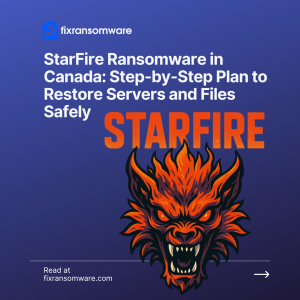When a company suddenly loses access to its file shares, VMs, and critical documents, the first Google search is often something like “StarFire ransomware in Canada data recovery”. By that point, StarFire has already encrypted servers and files, sometimes appending an extension like .starfire to everything that matters. The good news: if you respond correctly, StarFire ransomware in Canada does not automatically mean permanent data loss.
This guide walks Canadian IT teams and business owners through a practical, step-by-step recovery plan—focusing on safety and avoiding blind ransom payments.
What StarFire Ransomware Does to Your Servers and Files
StarFire behaves like many modern human-operated ransomware strains:
- It moves laterally through the network before “detonating”.
- It encrypts shared folders, project archives, finance documents, VMDK/VM files, and sometimes backups.
- It may partially encrypt online backup locations if they are always connected.
- It drops ransom notes demanding cryptocurrency and often threatens data leaks.
For organisations dealing with StarFire ransomware in Canada, the impact can include:
- Invoices, payroll, and customer operations grinding to a halt.
- Contract pressure from clients and partners expecting normal service.
- Potential privacy and regulatory concerns if personal data was accessed.
You cannot undo the breach, but you can control what happens next.
First 24 Hours: Contain StarFire Before You Do Anything Else
Effective StarFire ransomware data recovery in Canada always starts with containment, not reinstalling or paying.
- Isolate affected systems
- Disconnect encrypted servers, NAS devices, and workstations from the network.
- Temporarily disable VPN access if compromised remote endpoints might spread the attack.
- Do not delete encrypted data
- Encrypted files usually no longer contain active malicious code.
- These files are the core input for any serious recovery attempt—don’t “clean them up” out of frustration.
- Identify StarFire executables and persistence
- Look for suspicious services, scheduled tasks, startup entries, and binaries.
- Stop clearly malicious processes, but avoid wiping logs or evidence you may need later.
- Preserve evidence
- Keep ransom notes, firewall/VPN logs, endpoint security alerts, and phishing emails.
- This aligns with best-practice guidance like CISA StopRansomware and helps with internal reports and insurers.
The goal in this phase is simple: stop the bleeding and keep options open for restoring data safely.
Assessing Damage and Backups for StarFire Ransomware in Canada
Once things are stable, you can plan StarFire ransomware in Canada recovery steps more calmly.
a. Map what is really affected
- List which servers, NAS devices, and critical endpoints are encrypted.
- Separate business-critical systems (ERP, accounting, core file servers) from secondary ones.
b. Evaluate your backups honestly
- Identify offline, off-site, or immutable backups that StarFire could not reach.
- Test small restores in an isolated environment; never assume a backup is good until you’ve proven it.
c. Confirm it is StarFire
- Use file extensions, ransom note content, and attacker contact details to confirm that you are indeed facing StarFire.
- Correct identification helps specialists choose the safest approach instead of guessing.
d. Avoid random “miracle tools”
- Many tools found online either do nothing or damage data structures.
- A bad attempt can convert a recoverable StarFire ransomware case into permanent data loss.
This assessment stage is about building a realistic picture of what can be saved and how.
Why Paying the Ransom Is a Risky Shortcut
Sending crypto to the attackers may look like the fastest way out, but:
- There is no guarantee you will receive a working decryption key.
- Even with a key, decryption can be slow, partial, or corrupt some of your data.
- Your company may be flagged as a “paying target”, increasing the risk of repeat attacks.
- Legal, regulatory, and contractual issues remain, because the breach still happened.
For most organisations, a structured StarFire ransomware recovery plan is a better investment than directly funding the criminals.
Working With a Professional StarFire Ransomware Recovery Service
Internal IT teams are usually strong at day-to-day operations, but deep ransomware repair is a different skill set. That’s where a dedicated recovery service is useful.
A specialised team like FixRansomware typically:
- Performs sample-based technical assessment
- You provide a limited set of encrypted files and, if possible, original versions from backup.
- Specialists analyse these pairs to see whether safe decryption or low-level repair is technically viable.
- Runs test recovery in an isolated lab
- All experiments are performed on copies, never on your only production data.
- Only proven-safe methods are applied to full datasets.
- Restores by business priority
- Finance, ERP, and critical file servers are restored first; secondary services follow later.
- Management receives realistic timelines grounded in technical reality.
- Hardens the environment before full go-live
- Patch exposed services, close unnecessary ports, tighten remote access, and rotate credentials.
- Redesign backups with offline or immutable layers and regular restore drills.
You can submit small encrypted samples (under 1 MB) securely via app.fixransomware.com for initial analysis, then share larger datasets via cloud storage links when needed.
You cannot change the fact that StarFire ransomware in Canada hit your organisation—but you can choose whether the next step is panic and ransom payments, or a controlled, professional recovery process.


